How To Build A Hydroponics Garden

-Naomi Austin-
I started working at Fifth Season almost two years ago. I was hired because I love plants and am easy to talk to. Was I a super-experienced gardener? No, but I had basic gardening experience and wanted to learn (and HAVE learned) so much, by talking to customers and colleagues, and from my own experiences with plants at the store and at home. Now I am confident in my understanding of most plants' basic needs, including common garden plants and houseplants in the home. One area I really felt like I needed to develop more expertise in, however, was hydroponic gardening.
As a single mother of two young kids who also works full-time, I have a full plate; however, I was really tired of feeling like I couldn't offer any assistance to customers that came in for Hydroponic advice or products. Plus, we had a HORRIFIC growing season this year here in the Piedmont of North Carolina, so I was jonesing for some greens. Additionally, I have been becoming increasingly disgusted by the waste produced from plastic clam shells and plastic bags for organic greens, especially because I know greens are SUPER FAST and EASY to grow! I decided it was time to face my fears and try to run a SIMPLE AS POSSIBLE hydro setup to grow some lettuce. So, here is my little journey. I hope I can inspire you to get started as well!
WHAT I USED
THE BIN
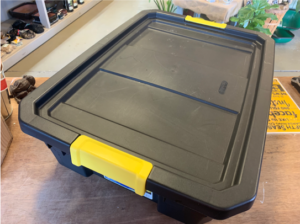
The hardest part was finding a bin for the water. I searched everywhere online but couldn't tell from the photos what was right for me. I ended up picking up a short but wide 10 gallon Sterilite black storage bin which was made of food grade plastic (check the number on the bottom of the bin and click here for further details). The handle had tiny holes where the locking mechanisms attached, but I just filled them with 100% silicone caulking to make sure the bubblers didn't cause leakage on my hardwood floors. It worked, and I was still able to keep the handles on and locked, so that my younger child (who is three) didn't try peeping and playing in the water at home!
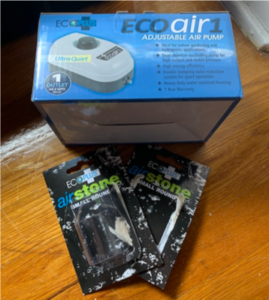
THE PUMP
I used the EcoPlus Air 1, which we carry here in the shop of course. This is the most basic pump that we carry, but all that is needed for this setup. It sits beside the bin and pumps air into the water through tubing and air stones for aeration of the roots. I chose to use aeration because it produces fuller and happier plants than the Kratky method (which I learned about during my research on how to best do a home setup).
AIR STONES, TUBING, & T-CONNECTOR
I used two small air stones, and 4 feet of quarter-inch black tubing (both available at Fifth Season) connected in thirds with a T-connector and then to the air pump. The air stones make tiny little bubbles that help bring oxygen into the water. This oxygenation is important to support root growth and to prevent the growth of algae and bacteria, which can deprive roots of nutrients.
THE LIGHT
At first, I was going to use a couple of 2-foot T5 fluorescent grow bulbs, but was told that while those lights would be fine for seedlings and small baby plants, they would not produce enough light for full-grown lettuce. So I went with a 125W Compact Fluorescent (CFL) – Blue (grow) Spectrum bulb and a compact fluorescent reflector.

2" NET CUPS
These 2-inch net cups held my seedlings, which I started in cellulose grow plugs.
I drilled 8 holes into the lid of the bin using a 2" hole saw attachment (cheap and easy to use), and set the net cups into the holes.
THE TIMER
I used an Apollo timer to automate my system so it turns on and off automatically, for maximized growth and efficiency. It's super basic. Nothing special, but totally effective. Plug it in, and set the pins to the desired time you want a flow of power.
THE NUTRIENTS
I mainly used Dyna-Gro: GROW and a small amount of General Hydroponics: Floralicious" for this project. I added nutrients on December 21, and again on January 8th (along with another gallon of lukewarm tap water).
THE SEEDS and STARTER PLUGS
I learned that fresh seeds are best. At first attempt, I used some leftover 2017 seeds for two of the lettuce varieties and 2018 seeds for the third because we had lots of spare seeds in the store to use for in-house projects. None of the 2017 (two year old) seeds came up. Wasted time. Some of the 2018 seeds did come up, but they seemed weaker. Once they started growing, they turned out fine, but overall, I would say the fresh seeds produced stronger plants right out of the gate.
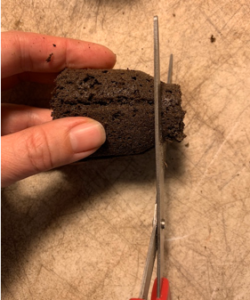
I went with starter plugs instead of rockwool (another popular hydroponic growing medium) because the plugs have mycorrhizae in them, and frankly, I had used them before with great results. Why mess up a sure thing? We sell grow plugs in small amounts too, (starting at a 10 count bag for $4.49), which was cheaper than the rockwool plugs, which had way more than I needed in the smallest package. PLUS, we also had spare grow plugs laying around, but no spare rockwool plugs. The decision was a no-brainer.
I put the seeds into the plugs, cut off the bottoms of the plugs, and tore them into pieces, which I tucked into the sides of the net pots to make sure no light got into the water bin when the net cops were sitting in the system. It's important to keep light out of the water, because light encourages algae growth, even with moving aerated water. The fewer chances you give the water to grow anything unintended in it, the better success you will have.
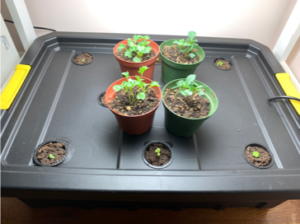
It took about two weeks of the plugs sitting under grow lights for the seedlings to come up and grow roots through the plug medium. As you can see in the photos, I also decided to start two different varieties of kale in soil, to kind of do a side by side comparison. The kale came up super quick and started growing happily, but shortly ran out of nutrients and just kind of sat there once they got 3 inches tall. So, while the hydro lettuce took longer getting started, it ended up blowing the kale out of the water, so to speak. 😉
THE SETUP
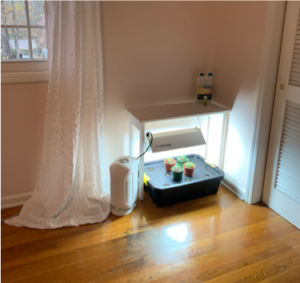
I put this setup in my bedroom in a corner I wasn't using. I used a little table I didn't need anymore to mount the light with 2 cup hooks and put the bin underneath that. A shelf would work perfectly fine as well, but since I had that table, I just used that rather than putting more holes in the wall. I also used a little fan which I also already had to blow air on the lettuce to keep the air moving and the heat down, although the lamp really didn't produce much heat at all. I then put a surge protector next to the table and plugged everything in. Voila! Easy peasy.
THE GROWING PROCESS
THE TRANSFER
On December 8, 2 weeks after planting, when the seedlings were ready, I simply filled the bin with about 8 gallons of city tap water from my bathtub faucet, put the lid pack on, and put the net pots with the seedlings in the holes of the lid. I didn't want to add the nutrients until the plants matured a little more, as that can burn the plant roots. So, I just went with tap water. I put the light on the timer that I set for 13 hours on and 11 hours off.
THE WAIT
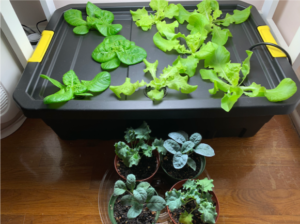
So, I waited… and waited… and those little suckers just sat there, hardly growing, for two weeks. Finally, on December 21, my patience ran out and I decided "may as well" and added some Floralicious and Dyna-gro GROW to the water. POW! Within days, those seedlings finally started to grow! Within one week, they had tripled in size. I kid you not, within a WEEK AND A HALF of adding those nutrients, on New Year's Day, I was ready to harvest my greens! The leaves ran out of room! By January 10th I had harvested leaves on three separate occasions, to keep the plants from bumping into each other too much and rotting!
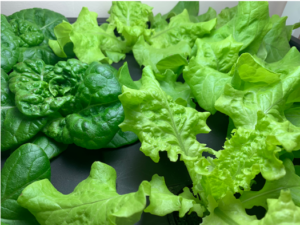
I have no complaints, and neither do my two children. Yeah, you read that right. My 3 year old was literally shoving fistfulls of this lettuce into her mouth. Not a fancy salad, either, just lettuce with a little bit of dressing and a couple of croutons. My 7 year old son (who hates salad, because he is 7 and prefers to be picky about everything he eats) also ate his salad without complaint (once he started chewing). The lettuce is buttery, soft, and not bitter AT ALL. It's FLAVORFUL, too! It has a wonderful texture you simply cannot buy at a grocery store, because it would perish too quickly on the shelves. It's a true delight to eat this stuff. I harvested a huge batch of leaves this morning before work and plan to eat ALL of it for dinner tonight, knowing in about 3-4 days, I will have just as much again to eat.
Lettuce is one of the hardest things to grow here in NC because the weather tends to get too hot too quickly. So unless I have the perfect spot, I usually only get a month or two of grow- time out of them in my tiny garden. NOT ANYMORE. I've found my solution! The hardest part will be the wait in between batches (waiting for seedlings). I may even invest in a simple seedling setup so that I have no big lag time in between rounds of lettuce once this batch is done producing and finally does become bitter or succumbs to root rot.
WHAT I LEARNED
A hydro setup can be simple, easy, take up very little space, and still be super successful. There is an initial investment, but compared to the plants you will lose to bugs, nutrient deficiencies, severe weather, animals, and disease, and the money you will spend on products trying to control those things and the soil, starts, seeds, and nutrients you would also buy, not to mention the money you would spend (mainly on plastic packaging) to buy inferior produce at the grocery store, hydro is a better investment for things like lettuce, kale, swiss chard, basil, mint, and other leafy greens and herbs.
I knew hardly anything about growing hydro when I started this project, and I did it successfully. That means you can too! DO IT! Feed your family and yourself spring delicacies YEAR-AROUND, save money, and enjoy the process of watching your green lovelies grow without the hassle of the common aforementioned issues.
How To Build A Hydroponics Garden
Source: https://fifthseasongardening.com/beginning-hydroponics-walking-through-a-simple-diy-hydro-setup
Posted by: hyerlorge1995.blogspot.com

0 Response to "How To Build A Hydroponics Garden"
Post a Comment